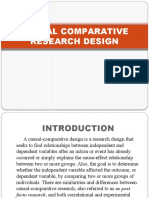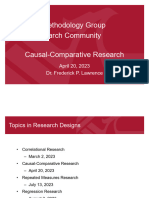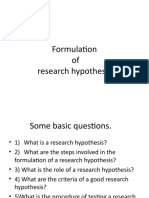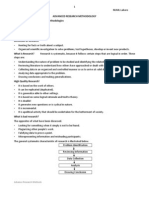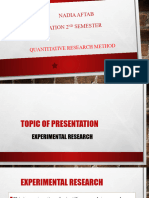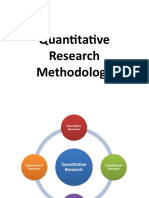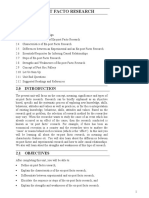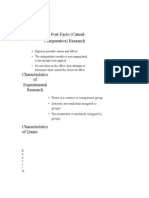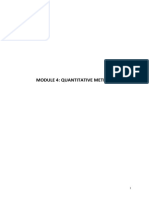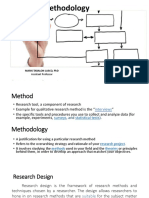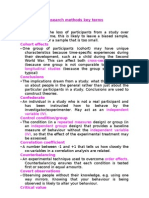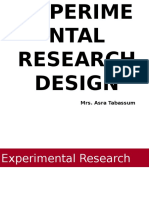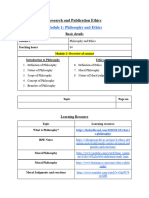0 ratings0% found this document useful (0 votes)
91 viewsChapter 15
Chapter 15
Uploaded by
Shinying ChiamThis document discusses ex post facto research, including its definition, characteristics, uses, advantages, and limitations. It also outlines the key steps involved in designing an ex post facto investigation.
Copyright:
© All Rights Reserved
Available Formats
Download as PPT, PDF, TXT or read online from Scribd
Chapter 15
Chapter 15
Uploaded by
Shinying Chiam0 ratings0% found this document useful (0 votes)
91 views16 pagesThis document discusses ex post facto research, including its definition, characteristics, uses, advantages, and limitations. It also outlines the key steps involved in designing an ex post facto investigation.
Original Description:
expost facto
Copyright
© © All Rights Reserved
Available Formats
PPT, PDF, TXT or read online from Scribd
Share this document
Did you find this document useful?
Is this content inappropriate?
This document discusses ex post facto research, including its definition, characteristics, uses, advantages, and limitations. It also outlines the key steps involved in designing an ex post facto investigation.
Copyright:
© All Rights Reserved
Available Formats
Download as PPT, PDF, TXT or read online from Scribd
Download as ppt, pdf, or txt
0 ratings0% found this document useful (0 votes)
91 views16 pagesChapter 15
Chapter 15
Uploaded by
Shinying ChiamThis document discusses ex post facto research, including its definition, characteristics, uses, advantages, and limitations. It also outlines the key steps involved in designing an ex post facto investigation.
Copyright:
© All Rights Reserved
Available Formats
Download as PPT, PDF, TXT or read online from Scribd
Download as ppt, pdf, or txt
You are on page 1of 16
EX POST FACTO
RESEARCH
© LOUIS COHEN, LAWRENCE MANION
& KEITH MORRISON
STRUCTURE OF THE CHAPTER
• Co-relational and criterion groups designs
• Characteristics of ex post facto research
• Occasions when appropriate
• Advantages and disadvantages of ex post facto
research
• Designing an ex post facto investigation
• Procedures in ex post facto research
TWO APPROACHES TO EX POST
FACTO RESEARCH
1. One commences with subjects who differ on
an independent variable, for example their
years of study in mathematics, and then
study how they differ on the dependent
variable, e.g. a mathematics test.
2. One commences with subjects who differ on
the dependent variable (for example their
performance in a mathematics test) and
discover how they differ on a range of
independent variables, e.g. their years of
study, their liking for the subject, the amount
of homework they do in mathematics).
EX POST FACTO RESEARCH AND
INDEPENDENT VARIABLES
Differing on the independent variable:
Presence of independent variable
Absence of independent variable
Degrees of independent variable
Investigate Effect on the dependent variable
Same on the independent variable(s)
Investigate Effect on the dependent variable
EX POST FACTO RESEARCH AND
DEPENDENT VARIABLES
Differing on the dependent variable
Differing on independent variables:
Presence of independent variables
Investigate Absence of independent variables
Degrees of independent variables
Same on the dependent variable
Differing on independent variables:
Presence of independent variables
Investigate Absence of independent variables
Degrees of independent variables
CO-RELATIONAL AND CRITERION
GROUP STUDY
• Co-relational study (causal research):
– to identify the antecedents of a present condition.
– collect two sets of data, one of which will be
retrospective, with a view to determining the
relationship between them.
• Criterion group study (causal-comparative
research):
– to discover possible causes for a phenomenon
being studied.
– Compare the subjects in which the variable is
present with similar subjects in whom it is absent.
TWO CAUSES AND TWO EFFECTS
IN CRITERION GROUP STUDY
EFFECT POSSIBLE CAUSE
Effective Presence of collegial
teaching curriculum planning
Ineffective Absence of collegial
teaching curriculum planning
Two criterion groups:
(a) Presence of collegial planning
(b) Absence of collegial planning
CHARACTERISTICS OF EX POST
FACTO RESEARCH
• In ex post facto research the researcher takes
the effect (or dependent variable) and
examines the data retrospectively to establish
causes, relationships or associations, and
their meanings.
EX POST FACTO RESEARCH IS
USEFUL WHEN . . .
• It is impossible, impractical, costly or
unethical to conduct an experiment.
• It is not possible to select, control and
manipulate the factors necessary to study
cause-and-effect relationships directly.
• When the control of all variables except a
single independent variable may be
unrealistic and artificial.
• Where the independent variable lies outside
the researcher’s control.
ADVANTAGES OF EX POST
FACTO RESEARCH
• Useful where the more rigorous experimental
approach is not possible.
• Useful to study what goes with what and
under what conditions.
• Useful where the setting up of the latter would
introduce a note of artificiality into research
proceedings.
• Useful where simple cause-and-effect
relationships are being explored.
• It can give a sense of direction and provide a
source of hypotheses that can subsequently
be tested by the more rigorous experimental
method.
DIFFICULTIES IN EX POST FACTO
RESEARCH
• Direction of causality difficult to establish: what
caused what.
• Lack of control of the independent variable or
variables.
• Impossible to isolate and control every possible
variable, or to know with absolute certainty which
are the most crucial variables.
• Randomization impossible.
• Can provide support for any number of different,
even contradictory, hypotheses.
• Correlation does not equal cause.
• Lack of control: the researcher cannot
manipulate the independent variable or
randomize her subjects.
DISADVANTAGES OF EX POST
FACTO RESEARCH
• One cannot know for certain whether the causative
factor has been included or even identified.
• It may be that no single factor is the cause.
• A particular outcome may result from different
causes on different occasions.
• It is not possible to disconfirm a hypothesis.
• Classifying into dichotomous groups can be
problematic.
• As the researcher attempts to match groups on key
variables, this leads to shrinkage of sample.
• Conclusions may be based on too limited a sample
or number of occurrences.
• It may fail to single out the really significant factor(s).
DESIGN AND PROCEDURES IN AN
EX POST FACTO INVESTIGATION
1. Identify the problem area to be investigated.
2. Formulate a hypothesis to be tested or questions to be
answered.
3. Make explicit the assumptions on which the hypothesis
and subsequent procedures will be based.
4. Review of the research literature will follow to ascertain
the kinds of issues, problems, obstacles and findings
disclosed by previous studies in the area.
5. Plan the actual investigation:
– identify the population and samples;
– select and construct techniques for collecting data;
– establish categories for classifying the data.
6. Describe, analyse and interpret the findings.
DESIGN AND PROCEDURES IN AN
EX POST FACTO INVESTIGATION
Stage One: Define the problem and survey the
literature.
Stage Two: State the hypotheses and the
assumptions or premises on which the
hypotheses and research procedures are
based.
Stage Three: Select the subjects (sampling)
and identify the methods for collecting the data.
Stage Four: Identify the criteria and categories
for classifying the data to fit the purposes of the
study.
DESIGN AND PROCEDURES IN AN
EX POST FACTO INVESTIGATION
Stage Five: Gather data on those factors which are
always present in which the given outcome occurs,
and discard the data in which those factors are not
always present.
Stage Six: Gather data on those factors which are
always present in which the given outcome does
not occur.
Stage Seven: Compare the two sets of data (i.e.
subtract the former (Stage Five) from the latter
(Stage Six), in order to infer the causes that are
responsible for the occurrence or non-occurrence of
the outcome.
Stage Eight: Analyze, interpret and report findings.
CONTROLS IN EX POST FACTO
RESEARCH
• Match the subjects in the experimental and
control groups where the design is causal-
comparative.
• Build the extraneous independent variables
into the design and then use an analysis of
variance technique.
• Select samples that are as homogeneous as
possible on a given variable.
• State and test alternative hypotheses that
might be plausible explanations for the
empirical outcomes of the study.
You might also like
- The Connor-Davidson Resilience Scale (CD-RISC) - Dimensionality and Age-Related Measurement Invariance With Australian CricketersDocument11 pagesThe Connor-Davidson Resilience Scale (CD-RISC) - Dimensionality and Age-Related Measurement Invariance With Australian CricketersBogdan HadaragNo ratings yet
- Case Report SampleDocument32 pagesCase Report Samplekhadija100% (1)
- Causal Comparative Research DesignDocument16 pagesCausal Comparative Research DesignNoemi Ruth Carrasco MesanaNo ratings yet
- Ex Post Facto ResearchDocument5 pagesEx Post Facto ResearchJulie Rin DoloresNo ratings yet
- Study Guide for Practical Statistics for EducatorsFrom EverandStudy Guide for Practical Statistics for EducatorsRating: 4 out of 5 stars4/5 (1)
- Causal Comparative ResearchDocument25 pagesCausal Comparative Researchprashant.kumar430No ratings yet
- Causal Comparative ResearchDocument25 pagesCausal Comparative Researchtibamaher1No ratings yet
- Unit 6 Ex-Post Facto ResearchDocument2 pagesUnit 6 Ex-Post Facto ResearchMr M DNo ratings yet
- Quantitative Research DesignDocument19 pagesQuantitative Research DesignAli Ahmed GhouriNo ratings yet
- Quantitative Research DesignDocument19 pagesQuantitative Research DesignShiela Marie Bahia100% (5)
- Quantitative Research DesignDocument30 pagesQuantitative Research Designpristine hollysaNo ratings yet
- Quantitative METHODS OF RESEARCH - Theoretical FrameworkDocument36 pagesQuantitative METHODS OF RESEARCH - Theoretical FrameworkRhenan LoseoNo ratings yet
- Research Methodology Meaning of ResearchDocument2 pagesResearch Methodology Meaning of Researchsandesh28mayNo ratings yet
- Causal Comparative Research - FullDocument38 pagesCausal Comparative Research - FullTừ Quỳnh NhưNo ratings yet
- Pengumpulan Data KuantitatifDocument52 pagesPengumpulan Data KuantitatifAini Syazwani100% (1)
- 5) Formulation of Research HypothesisDocument16 pages5) Formulation of Research HypothesisKranthi Tripura100% (1)
- Experimental MethodologyDocument8 pagesExperimental Methodologyralston204No ratings yet
- Quantitative Research DesignDocument27 pagesQuantitative Research Designkim.lastimaNo ratings yet
- Ex Post Facto and OthersDocument55 pagesEx Post Facto and OthersRhea M. LucenaNo ratings yet
- Understanding Data and Ways To Systematically Collect Data 2018Document321 pagesUnderstanding Data and Ways To Systematically Collect Data 2018gin black100% (2)
- Causal Comparative ResearchDocument24 pagesCausal Comparative Researchதுர்காதேவி சௌந்தரராஜன்No ratings yet
- Chapter 7Document21 pagesChapter 7Ulfie GhiezaNo ratings yet
- Causal Comparative ResearchDocument31 pagesCausal Comparative ResearchJe-Ann EstriborNo ratings yet
- Advance Research MethodsDocument17 pagesAdvance Research Methodsm_4_maina9376No ratings yet
- Research 1st LectureDocument23 pagesResearch 1st LectureJanee JaneNo ratings yet
- 11 QuantitativeDocument26 pages11 QuantitativeAham Baat by WAQASNo ratings yet
- Quantitative Research MethodologyDocument27 pagesQuantitative Research MethodologyJelly SagunNo ratings yet
- MBM 512Document76 pagesMBM 512Amit KumarNo ratings yet
- Quantitative Research DesignDocument19 pagesQuantitative Research DesignDarren CariñoNo ratings yet
- PR2 Characteristics Strengths Weaknesses Kinds of Quantitative ResearchDocument35 pagesPR2 Characteristics Strengths Weaknesses Kinds of Quantitative ResearchJheanne Grace AbejeroNo ratings yet
- RMS AsignmentDocument6 pagesRMS AsignmentVilayat AliNo ratings yet
- Causal Comparative ResearchDocument28 pagesCausal Comparative ResearchRoldan Dela CruzNo ratings yet
- Midsem NotesDocument6 pagesMidsem Notesaditya.shajiNo ratings yet
- Group 4 - Ex Post Facto ResearchDocument10 pagesGroup 4 - Ex Post Facto ResearchSteviona ElizaNo ratings yet
- Nature of Inquiry and ResearchDocument5 pagesNature of Inquiry and ResearchLoren c Agyapas50% (2)
- Quantitative ReviewerDocument14 pagesQuantitative ReviewerDEZA, Arabela Grace A.No ratings yet
- Ex Post Facto ResearchDocument10 pagesEx Post Facto Researchtiyasadey0012No ratings yet
- Research MethodDocument30 pagesResearch Methodmahmoudkhal334No ratings yet
- Ex Post Facto ExplainedDocument20 pagesEx Post Facto ExplainedJhude JosephNo ratings yet
- Causal Comparative ResearchDocument24 pagesCausal Comparative ResearchFernandez Sigalingging100% (1)
- Research MethodDocument2 pagesResearch MethodFitriani HamidahNo ratings yet
- 10 - Conducting A Literature Review and True and Quasi Experimental Designs, Validity and Ethical Issues Experimental ResearchDocument25 pages10 - Conducting A Literature Review and True and Quasi Experimental Designs, Validity and Ethical Issues Experimental ResearchbycghzslonmflzadcbNo ratings yet
- Experimental Research - Cerilo H.Document52 pagesExperimental Research - Cerilo H.Jelyn MamansagNo ratings yet
- Ex Post Facto ResearchDocument12 pagesEx Post Facto ResearchAlyanna DiolaNo ratings yet
- Ex Post Facto (Causal-Comparative) ResearchDocument5 pagesEx Post Facto (Causal-Comparative) ResearchsshailiNo ratings yet
- Causal Comparative Studies (Ex-Post Facto)Document11 pagesCausal Comparative Studies (Ex-Post Facto)Music LifeNo ratings yet
- 3 EngDocument6 pages3 EngREYMARK PERALTANo ratings yet
- Experimental and Action Research FareedullahDocument11 pagesExperimental and Action Research FareedullahAttaullah KhanNo ratings yet
- CH07 PPTDocument25 pagesCH07 PPTAliaa HabibNo ratings yet
- Research EssentialsDocument21 pagesResearch EssentialssINO iTONo ratings yet
- Non Experimental DesignDocument52 pagesNon Experimental DesignAmal B Chandran100% (1)
- RM - Module 4 - Quantitative Method (Week 6-7-8)Document24 pagesRM - Module 4 - Quantitative Method (Week 6-7-8)Minh KhuêNo ratings yet
- Lesson-2-Final ModuleDocument39 pagesLesson-2-Final Modulespg9m2gjn2No ratings yet
- 8604 Unit 4 Revised Experimental Research 1Document22 pages8604 Unit 4 Revised Experimental Research 1amirkhan30bjrNo ratings yet
- MetlitDocument8 pagesMetlitWafa HanifahNo ratings yet
- Definition and PurposeDocument6 pagesDefinition and PurposeHerrieGabicaNo ratings yet
- Types of Research Design: - Exploratory Research - Descriptive Research - Causal ResearchDocument11 pagesTypes of Research Design: - Exploratory Research - Descriptive Research - Causal Researchkajal_pal25No ratings yet
- Lesson 3 Research Methodology October 10 2022Document37 pagesLesson 3 Research Methodology October 10 2022Makiling Carlos Jr.No ratings yet
- Research Methods Key TermsDocument7 pagesResearch Methods Key Termschloeee3888No ratings yet
- Experimental ResearchDocument194 pagesExperimental Researchasra100% (1)
- Research Proposal a Simplified Step-by-Step Guide - Revised EditionFrom EverandResearch Proposal a Simplified Step-by-Step Guide - Revised EditionNo ratings yet
- Art Integrative Lesson PlanDocument7 pagesArt Integrative Lesson Planapi-295905700No ratings yet
- Homeroom Guidance Monitoring Tool: Balingasa Elementary School - Grading - School YearDocument3 pagesHomeroom Guidance Monitoring Tool: Balingasa Elementary School - Grading - School YearJoy RosarioNo ratings yet
- CAE Reading and Use of English Practice Test 6 PrintableDocument4 pagesCAE Reading and Use of English Practice Test 6 PrintableNicoleta Danila100% (1)
- University of Southern Philippines Foundation Mabini CampusDocument3 pagesUniversity of Southern Philippines Foundation Mabini CampusLetlie Zoilo SemblanteNo ratings yet
- Chapter 10: Proposals and Formal Reports: Business CommunicationDocument37 pagesChapter 10: Proposals and Formal Reports: Business CommunicationKhánh Ngọc100% (1)
- JIUP - Deny ArdiantoDocument14 pagesJIUP - Deny Ardiantom84005254No ratings yet
- English 2 Schedule and ReviewDocument16 pagesEnglish 2 Schedule and ReviewRohmanatul InayatiNo ratings yet
- Guidelines For Internship ReportDocument10 pagesGuidelines For Internship ReportUmer KhanNo ratings yet
- LearnEnglish Business Magazine Writing Good CVDocument5 pagesLearnEnglish Business Magazine Writing Good CVteshome birhanuNo ratings yet
- Pause Giant AI Experiments: An Open LetterDocument3 pagesPause Giant AI Experiments: An Open LetterFotografía DigitalNo ratings yet
- Uts Midterm ReviewerDocument16 pagesUts Midterm ReviewerBryan SolivenNo ratings yet
- Dissertation Reflective Report SampleDocument5 pagesDissertation Reflective Report SampleWhatShouldIWriteMyPaperOnUK100% (1)
- Research Chpter 1 With Chpter 2Document3 pagesResearch Chpter 1 With Chpter 2Aron JaroNo ratings yet
- CIPR Specialist Diploma (Public Affairs) Syllabus For PublicationDocument4 pagesCIPR Specialist Diploma (Public Affairs) Syllabus For PublicationedwinexNo ratings yet
- 1 SM PDFDocument6 pages1 SM PDFZerry Reza SyahrulNo ratings yet
- Customer Experience Management in Retailing: Understanding The Buying ProcessDocument27 pagesCustomer Experience Management in Retailing: Understanding The Buying ProcessAlif NajmiNo ratings yet
- Believe in YourselfDocument3 pagesBelieve in Yourselfsoumitra paulNo ratings yet
- RPE Notes ModuleDocument85 pagesRPE Notes ModuleshwethaNo ratings yet
- English10Quarter2Module1 1Document23 pagesEnglish10Quarter2Module1 1Keziah LapojaNo ratings yet
- Perceived Organizational SupportDocument20 pagesPerceived Organizational SupportDivanoNo ratings yet
- Example: An Academic Essay Structure (Rolls & Wignell, 2013, P 55)Document1 pageExample: An Academic Essay Structure (Rolls & Wignell, 2013, P 55)CinthyaNo ratings yet
- Pqe 7001 Second Language Acquisition Jigsaw Reading Week 7: Lecturer'S NameDocument4 pagesPqe 7001 Second Language Acquisition Jigsaw Reading Week 7: Lecturer'S NameviniNo ratings yet
- ES Mini Project RubricsDocument4 pagesES Mini Project RubricsSourabh KoshtiNo ratings yet
- Grade 10 English DLL Q1 2022 2023 WEEK 6Document5 pagesGrade 10 English DLL Q1 2022 2023 WEEK 6Sai Mendez Puerto Judilla-SolonNo ratings yet
- Psych Event CalDocument2 pagesPsych Event CalrajrudrapaaNo ratings yet
- DM 02 04 Data TransformationDocument52 pagesDM 02 04 Data Transformationmaneesh sNo ratings yet
- BetelDocument4 pagesBetelabrehamcheru1No ratings yet
- Prepare 2 SB PDF Language Mechanics GrammarDocument7 pagesPrepare 2 SB PDF Language Mechanics GrammarВиктория КопаNo ratings yet


